Enhancing the Mechanical Properties of MXene Films: A Key Path to Building High-Performance Flexible Lithium Metal Anodes
QQ Academic Group: 1092348845
Detailed
With the rapid development of portable wearable electronic devices, flexible, safe and high energy density energy storage devices have gradually become a research focus. The metal lithium secondary battery has become a promising candidate due to its ultra-high theoretical specific capacity. However, the problem of lithium dendrites caused by the uneven deposition of metal lithium and the volume change problem of the lithium negative electrode during cycling have seriously affected the safety and service life of the battery. In addition, due to the rapid consumption of lithium resources, the issue of the utilization rate of the lithium negative electrode also requires attention. The development of ultra-thin flexible self-supporting carriers can effectively solve the above problems. Two-dimensional transition metal carbon/nitride (MXene) has great application potential in the field of energy storage due to its high conductivity, graphene-like structure, rich functional groups, and easy film formation. However, the general MXene film has poor mechanical properties, and MXene is prone to re-stacking during cycling, which limits its practical application in flexible metal lithium negative electrodes. Therefore, exploring and developing MXene-based ultra-thin flexible self-supporting electrodes is extremely valuable.
【Job Introduction】
Recently, Professor Guo Zaiping from the University of Wollongong in Australia, Associate Researcher Ye Huan and Professor Feifei Cao of Huazhong Agricultural University have collaborated to design an interlocking topology, which combines MXene nanosheets and nanocellulose (CNF) with self-assembly and electrochemical deposition. Process, successfully prepared ultra-thin flexible metal lithium composite anode (MXene@CNF/Li). The obtained metal lithium composite negative electrode is matched with the flexible positive electrode to assemble a flexible full battery, showing excellent electrochemical performance. The related results were published in the top international journal Nano Energy. The first authors of the paper are graduate student Wang Caoyu of Huazhong Agricultural University and associate professor Zheng Zijian of Hubei University.
The research results show that MXene and CNF can self-assemble through hydrogen bonds and form MXene@CNF microspheres in the process of rotary evaporation. The formed MXene@CNF microspheres and surplus MXene sheets overlap each other to form an interlocking topological structure, which enhances the interaction between the interfaces and significantly improves the mechanical strength and flexibility of the MXene@CNF film. In addition, the sandwich structure of MXene sheet and MXene@CNF microspheres can effectively prevent the re-stacking of MXene and improve the lithium ion transmission kinetics. The expanded layer spacing can accommodate more metal lithium and achieve higher surface capacity lithium deposition. The abundant lithium-philic functional groups on the surface of MXene can form a strong mutual adsorption with lithium, which induces uniform nucleation of metallic lithium and subsequent non-dendritic growth. Thanks to the above advantages, the constructed composite lithium anode can achieve an ultra-thin thickness of ~25 μm, and the assembled symmetrical battery can cycle stably for more than 1300 hours at a current density of 0.5 mA/cm2. In addition, the ultra-thin MXene@CNF/Li composite lithium negative electrode is matched with the flexible self-supporting LFP@CNF composite positive electrode to assemble a flexible full battery. The flexible full battery is cycled for nearly 100 times at 0.2 C, and the capacity retention rate can be maintained at about 95.25%, showing good cycle stability. This work not only provides an idea for the simple and large-scale preparation of ultra-thin, flexible and self-supporting MXene-based films, but also broadens the practical application of MXene-based materials in the field of flexible energy storage.
【Content Expression】
As shown in Figure 1, MXene and nanocellulose (CNF) self-assemble through hydrogen bonds to form an interlocking topological structure film. The flexible MXene@CNF/Li lithium composite negative electrode constructed with this film as a carrier exhibits high mechanical strength and toughness. The flexible MXene@CNF/Li lithium composite negative electrode can maintain good film characteristics without damage after repeated bending-recovery.

Figure 1. Schematic diagram of the MXene@CNF topology.
By etching with hydrochloric acid and lithium fluoride, MXene nanosheets with a size of 1~2μm were obtained (Figure 2a-c). After fully mixing the suspension containing MXene nanosheets and the colloidal solution of CNF, the MXene@CNF flexible film with interlocking topology is obtained by rotary evaporation technology. The MXene@CNF flexible film exhibits excellent mechanical properties and flexibility, and can be folded into various shapes (Figure 2d). Scanning electron microscopy (SEM) characterization showed that the thickness of the MXene@CNF film was about 20 μm (Figure 2e). The film is composed of MXene nanosheets and MXene@CNF microspheres overlapping each other to form an interlocking topology (Figure 2f-g). In order to explore the structure and composition of the microspheres, the author performed transmission electron microscopy (TEM) image characterization and EDX element analysis. The results show that Na, C, F, and Ti elements are uniformly distributed on the microspheres (Figure 2h-l), indicating that the microspheres are assembled by layers of nanosheets.
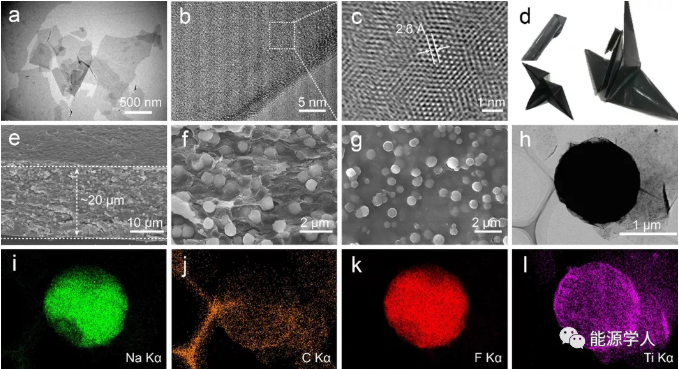
Figure 2. (a) TEM image of MXene nanosheets. (B) HRTEM image of MXene nanosheets, and (c) the corresponding lattice spacing. (D) MXene@CNF origami optical photo. (E), (f) SEM image of the cross section of the MXene@CNF film, and (g) plane SEM image. (H) TEM image of MXene@CNF microspheres, and (i~l) corresponding EDX element energy spectrum image.
The formation mechanism of MXene@CNF microspheres is shown in Figure 3. From a thermodynamic point of view, the surface of MXene and cellulose are rich in -O, -OH, -F groups, which tend to interact to form intramolecular hydrogen bonds, self-assemble to form lamellar micelles, and reduce the enthalpy change of the system DH. In the process of rotary evaporation, lamellar micelles are curled to form spherical micelles under the action of drum granulation. Under the action of hydrogen bonds, lamellar micelles and spherical micelles further self-assemble layer by layer to form MXene@CNF Microspheres. Finally, a sandwich structure composed of lamellar micelles and microspheres is obtained. This unique topological structure helps to enhance the mechanical strength and flexibility of the membrane material.
Compared with pure MXene film, MXene@CNF composite film has the following advantages: (1) The interlocking topology between the lamellae and the microspheres can enhance the interaction between the interfaces and improve the mechanical properties of the flexible lithium metal anode; (2) ) Ultra-thin self-supporting MXene@CNF/Li lithium composite anode, which is beneficial to the rapid transmission of lithium ions and electrons, ensuring high lithium utilization and good rate performance; (3) The abundant polar functional groups on the surface can be used as lithium-philic The nucleation sites can induce uniform deposition of lithium metal; (4) This method is simple and low in cost, which is convenient for future popularization and application.
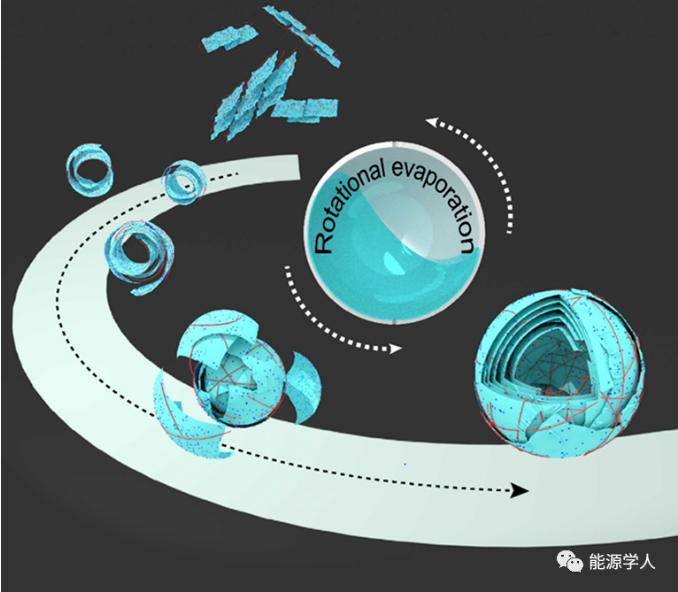
Figure 3. Schematic diagram of MXene@CNF microsphere formation.
First-principles theoretical calculations show that the abundant polar functional groups on the surface of MXene have a strong binding ability with lithium atoms, which can induce uniform nucleation and growth of metallic lithium during the lithium deposition-precipitation process (Figure 4a). The author studied the morphology difference of the deposited metal Li on the surface of flat Cu, MXene film and MXene@CNF under the same current density (0.5 mA/cm2) by scanning electron microscope (SEM). Due to the unevenness of the microscopic surface of the copper foil, needle-like lithium can be detected on the surface of the copper foil. Thanks to the inducing effect of the polar functional groups on MXene on the deposition of metallic lithium, petal-like Li deposits are regularly dispersed on the MXene film. Li also showed a petal-like form on MXene@CNF.
After 0.5 mA h/cm2 lithium was deposited, there were petal-like spots on some of the microspheres (Figure 4b, f), and dendritic lithium was not visible on the surface and inside. When the metal lithium deposition capacity increased to 1 mA h/cm2, the surface of the MXene@CNF film was almost completely covered with petal-like lithium (Figure 4c, g). As the deposited lithium capacity further increases to 2mA h/cm2, the petal-like lithium remains well, and the internal hierarchical structure begins to fill and become compact (Figure 4d, h). Because the MXene@CNF film has a large interlayer spacing, it can provide sufficient space for the deposition of metal lithium and slow down the volume change of the metal lithium anode. Therefore, the structure of the film remains stable after the metal lithium is removed (Figure 4e, i).
The author further used ToF-SIMS to characterize the MXene@CNF/Li negative electrode. The study showed that the spatial distribution of Li elements on the film is consistent with the spatial distribution of F and O elements, indicating that metallic lithium is well distributed on the surface and effectively It is contained in the interlayer of the MXene@CNF film, which is consistent with the above SEM image. This result also reflects from the side that there is a strong interaction between the polar functional groups on the surface of MXene and Li, which can be used as deposition sites to induce uniform deposition of metallic lithium on the film and avoid the formation of metallic lithium dendrites.
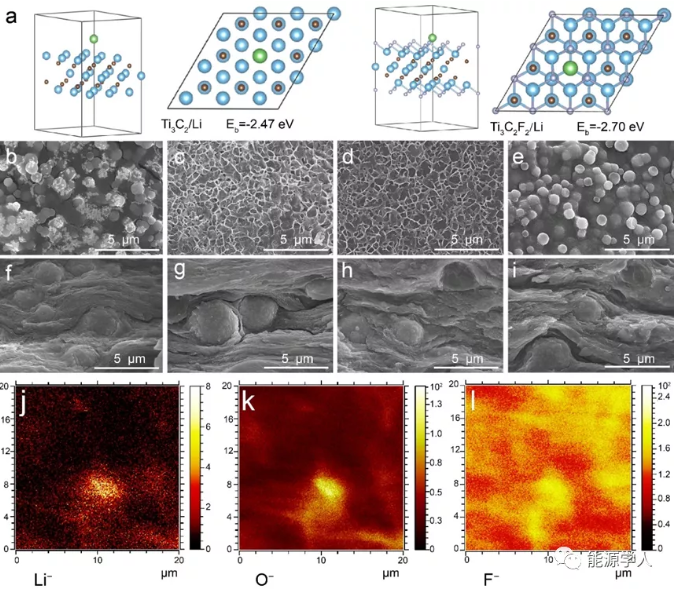
Figure 4. (a) The binding energy between Li atoms and Ti3C2 and Ti3C2F2. SEM image of metallic lithium deposited on MXene@CNF film (b) 0.5 mA h/cm2, (c) 1 mA h/cm2, (d) 2 mA h/cm2, and corresponding cross-sections (f), (g), (H) SEM image. (E), (i) SEM image of lithium metal after being separated from MXene@CNF. ToF-SIMS was used to characterize the element distribution (2 mA h/cm2) of (j) Li, (k) O, (l) F on the negative electrode of MXene@CNF/Li.
The uniform deposition of lithium metal on MXene@CNF is beneficial to improve the coulombic efficiency and cycle life of the lithium metal anode (Figure 5). Studies have shown that at an area capacity of 2 mA h/cm2 and a current density of 0.5 mA/cm2, the initial coulombic efficiency of metallic lithium on MXene@CNF reaches 82.5%, and the efficiency can be stabilized at about 98.9% when the cycle is >200 cycles. The constructed MXene@CNF/Li symmetrical battery has a stable cycle for more than 1300 h at a current density of 0.5 mA/cm2 and the voltage can be stabilized at about 50 mV.
In order to further study the bending resistance of the MXene@CNF/Li flexible composite anode, the author took out the stable cycle Cu/Li anode and MXene@CNF/Li anode from the battery and performed dozens of bending tests. The results showed that after the folding test, the metal lithium deposited on the surface of the copper foil peeled off or even fell off from the surface of the copper foil, and due to the metal fatigue effect, the copper foil surface was creases or even broken. The MXene@CNF/Li flexible anode has better mechanical properties, and the composite lithium anode structure remains intact. Recycling the negative electrode after the bending test, the Cu/Li negative electrode quickly failed, but the MXene@CNF/Li flexible negative electrode can still be cycled normally. This shows that the flexible composite negative electrode can be applied to flexible devices.
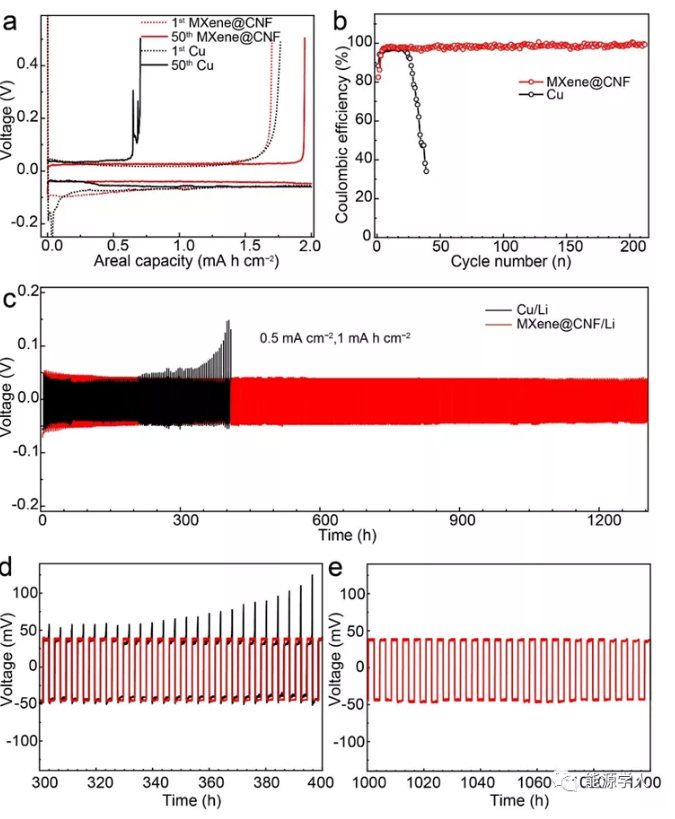
Figure 5. (a) When the current density is 0.5 mA/cm2 and the deposition amount of lithium is 2 mA h/cm2, the constant current charge and discharge curves of MXene@CNF and Cu lithium insertion/delithiation, corresponding to (b) Coulomb efficiency. (C) Symmetrical battery test of MXene@CNF/Li and Cu/Li negative electrodes at 0.5 mA/cm2 current density, and (d) 200~400 h, (e) 1000~1100 h partial enlarged view.
In order to test the applicability of MXene@CNF/Li composite negative electrode, the author matched it with a high-load lithium iron phosphate positive electrode to construct a full battery. In the charge and discharge voltage range of 2.0-4.0 V, MXene@CNF||LFP full battery exhibits higher specific capacity and longer cycle life than Cu||Li full battery. Benefiting from the above-mentioned topology advantages of the MXene@CNF/Li composite anode, the MXene@CNF||LFP full battery exhibits good rate performance, and can exhibit a reversible specific capacity of 120 mAh/g at a rate of 2 C. The author further used MXene@CNF/Li anode and LFP@CNF flexible anode to assemble a flexible full battery, and explored its feasibility in constructing flexible devices. Studies have shown that at a rate of 0.2 C, the MXene@CNF/Li||LFP@CNF flexible full battery can exert a specific capacity of more than 150 mA h/g, and the cycle is close to 100 cycles, and the capacity retention rate can be maintained at 95.25%. Shows the application prospect of MXene@CNF/Li composite anode in flexible energy storage devices.
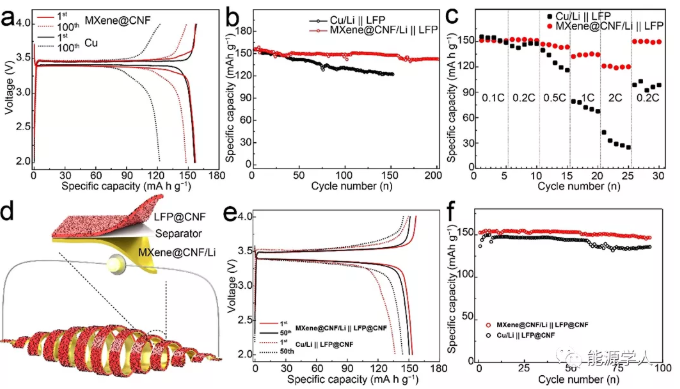
Figure 6. (a) MXene@CNF/Li||LFP, Cu/Li||LFP full battery constant current charge and discharge curve at 0.2 C and (b) the corresponding cycle performance, (c) rate performance. (D) Schematic diagram of MXene@CNF/Li||LFP@CNF flexible full battery. (E) MXene@CNF/Li||LFP@CNF, Cu/Li||LFP@CNF flexible full battery charge and discharge curve at 0.2 C constant current and (f) the corresponding cycle performance.
【to sum up】
An ultra-thin (~25 μm), flexible, and self-supporting Ti3C2Tx-MXene@CNF film prepared based on the design idea of interlocking topology is reported. Thanks to the interlocking microstructure between the MXene sheet and MXene@CNF microspheres, the MXene@CNF film exhibits good mechanical strength and flexibility, and the expanded interlayer spacing ensures the higher surface capacity and rate performance of the lithium anode. The rich lithium-philic functional groups on the surface of MXene exhibit a strong interaction with Li, which can induce uniform deposition of Li metal and avoid the growth of lithium dendrites. The composite lithium negative electrode is cycled 250 times at a current density of 1 mA/cm2 and still maintains a coulombic efficiency of 98.9%. The composite lithium negative electrode exhibits a long cycle life (0.5 mA/cm2 cycle 1300 h). The flexible full battery assembled based on the flexible MXene@CNF/Li composite negative electrode and the flexible self-supporting LFP@CNF positive electrode shows good long-cycle stability, with a cycle of about 100 cycles and a capacity retention rate of 95.25%. This work not only provides an idea for the simple and large-scale preparation of ultra-thin, flexible and self-supporting MXene-based films, but also broadens the practical application of MXene-based materials in the field of flexible energy storage.
Cao-Yu Wang, Zi-Jian Zheng, Yong-Qiang Feng, Huan Ye*, Fei-Fei Cao*, and Zai-Ping Guo*,Topological Design of Ultrastrong MXene Paper Hosted Li Enables Ultrathin and Fully Flexible Lithium Metal Batteries, Nano Energy, 2020, DOI: 10.1016/j.nanoen.202
Source: Energist Energy Scholar
This information is from the Internet for academic exchanges only. If there is any infringement, please contact us to delete it immediately.
- Previous: CEJ: High-stability V-
- Next: IF 26.8! Permeation ca


 mxene academic
mxene academic